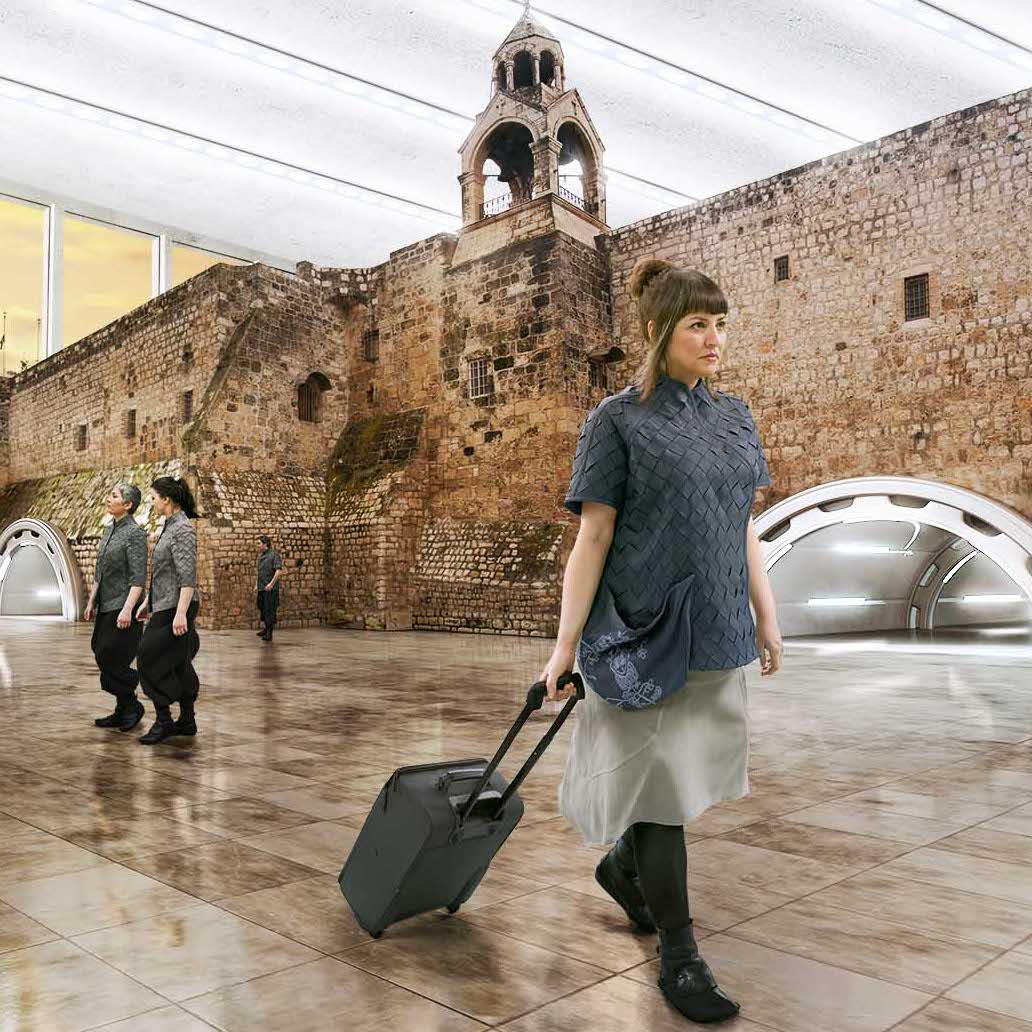Palestinian artists have refused to surrender their aesthetic sensibilities
… The instant the criterion of authenticity ceases to be applicable to artistic production, the total function of art is reversed. Instead of being based on ritual, it begins to be based on another practice – politics.
- Walter Benjamin, The Work of Art in the Age of Mechanical Reproduction
In exploring the connection between Palestinian art and its politics, one wonders whether it is possible to ‘escape’ the language of politics. In doing so, it is important to look at the historical and cultural transformations endured by the Palestinians to date, particularly the state of exile created as a result of the Nakba (lit. ‘Catastrophe’) in 1948. Every year, Palestinians commemorate the expulsion and dispossession of hundreds of thousands of Palestinians – more than 60% of the Palestinian population, to be more precise – from over 530 villages that were depopulated and destroyed completely. To date, the Israeli government has prevented the return of approximately six million Palestinian refugees, who have either been expelled or displaced. Looking back at the Nakba, one is compelled to conclude that perhaps not a small part of the suffering of the Palestinian people is directly related to that event.
In discussing the form of art that emerged in Palestine as a result of the prolonged struggle for freedom and liberation, as well as analysing and understanding the interrelation of political and artistic developments therein, it is useful to employ the approach of the German philosopher and literary critic Walter Benjamin. The condition of exile – to put it broadly – is one of the particular political factors that has influenced Palestinian artists over the years, as well as their choice of subject matter. In this context, art has become, perhaps, the perfect medium for the idea of liberation.
Edward Said, the Palestinian-American scholar, in an essay entitled Reflections on Exile described exile as:
… Strangely compelling to think about but terrible to experience. It is the unhealable rift forced between a human being and a native place, between the self and its true home: its essential sadness can never be surmounted.
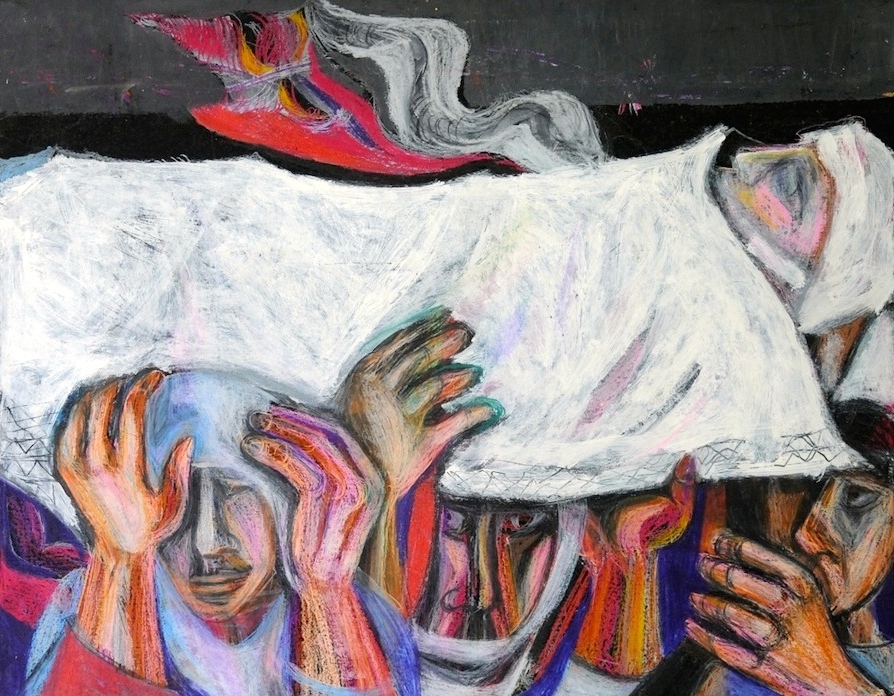
Abed Abdi - Intifada
Exile in the Palestinian context does not only include the six million Palestinians who live in a ‘foreign’ land and are no longer allowed to return, but also the five million displaced natives living as refugees in Israel, the West Bank, and Gaza. Said, in the aforementioned essay, argued that the displacement experienced by exiles abroad called for a reconstruction of their historical past as a way to find a ‘common ground’ where they could identify as a group and overcome their solitude. Thus, with respect to Palestine, exiles living outside the country identify with those living inside it, making the Palestinian cause and the dispossession of the Palestinian homeland common ground.
But what does it mean to have a common ground in this context, and in relation to art? An interesting artistic manifestation of this question can be seen in the work of Mary Tuma, a Palestinian artist and professor who lives and works in the United States. For her installation piece Homes for the Disembodied, she created 45 metres of black chiffon to design five connected dresses that hung in Houston’s Station Museum in 2003, casting a shadow on current events she described as being ‘dispossessed’ and ‘disembodied’. Tuma, who lives in exile, created these dress forms ‘so that those who couldn’t go back would have a place to dwell when they eventually returned’. The installation was meant to be displayed in Jerusalem as a sort of memorial/claim to territory, and to serve as ‘an invitation to those Palestinians who died before they ever were able to return home, some [of which] lived just a few miles away but were not permitted to enter Jerusalem’. The notion of returning that Tuma explored in the installation is an example of the ‘common ground’ linking those outside Palestine with those within, as well as the bond uniting them to overcome, in the words of Said, the ‘gap forced between the self and its true home’.
The condition of exile … is one of the particular political factors that has influenced Palestinian artists over the years, as well as their choice of subject matter. In this context, art has become, perhaps, the perfect medium for the idea of liberation
As Benjamin argued in his essay The Author as Producer, ‘The author must revolutionise artistic technique to give it a political function within contemporary production relations’. Just like the ‘author’ Benjamin referred to, Palestinian artists working under severe sociopolitical circumstances are making significant contributions and imbuing their art with political meaning; or, in other words, giving it a ‘political function’. For these artists, the urgency of mere survival and continued resistance is most pertinent to their work. Their art lies, as artist and writer Mark Prince noted in an article entitled Art and Politics, ‘in the act of reaching beyond the [artistic] context to capture a form of collective political expression’.
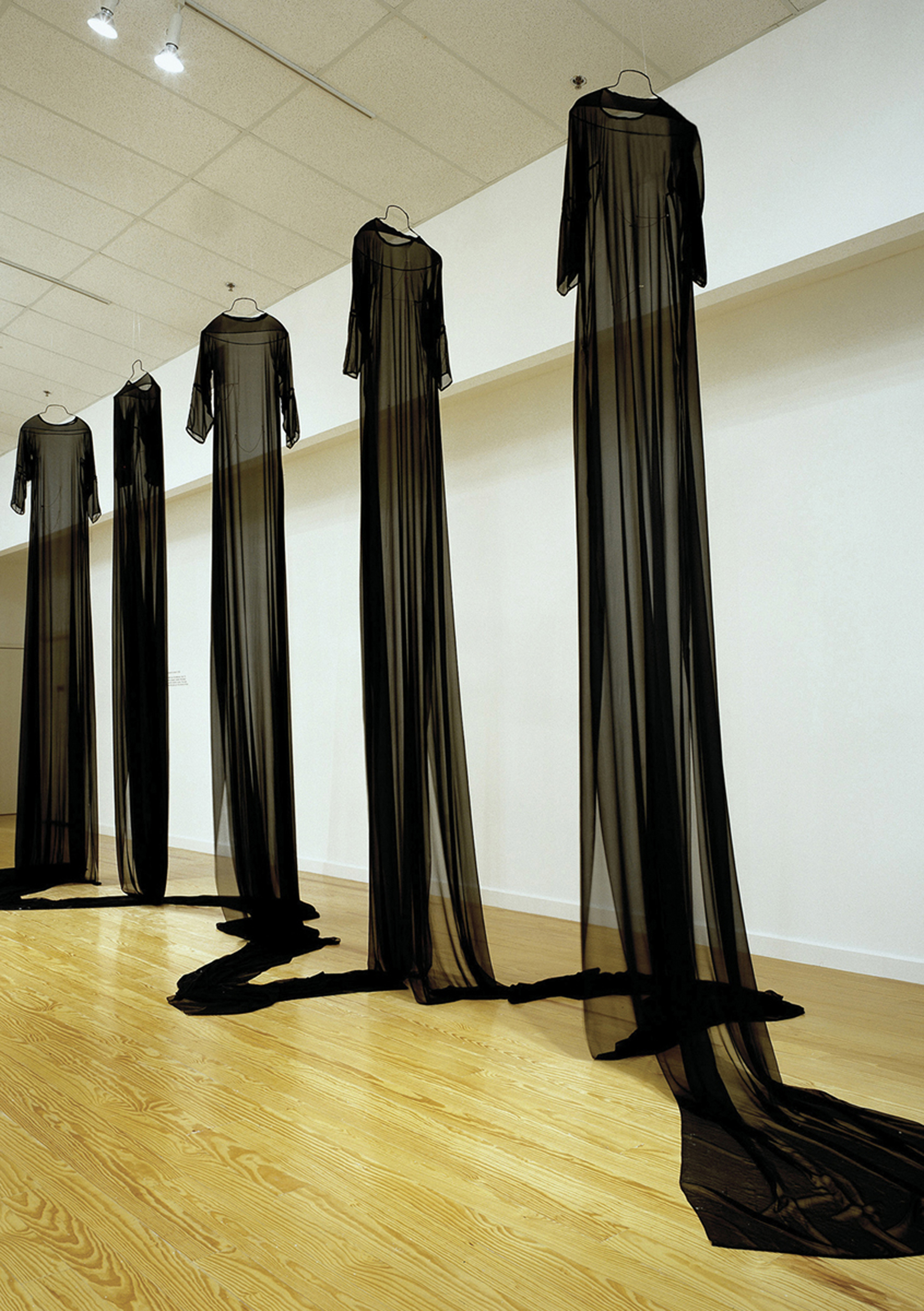
Mary Tuma - Homes for the Disembodied
That being said, however, it is essential in such a context to make comparisons with episodes in modern history where politics and art became intertwined. For instance, one can look to apartheid South Africa, where local art was affected by the state of exile suffered by native South Africans. The view that art has a social responsibility dominated artistic production in South Africa in the 80s, when the ‘exiled’ African National Congress (ANC) declared that art should be used as a ‘weapon’ in the political struggle for liberation. At Culture in Another South Africa, an arts conference held in Amsterdam in 1987, it was stated that a person is first and foremost part of a struggle, and only second a cultural worker or artist. The result of such views were the production of ‘committed’ or ‘protest’ art that strove to resist the political oppression at the time in delivering messages of hope and liberation. Albie Sachs, a South African ANC member and author, argued that:
In the case of a real instrument of struggle, there is no room for ambiguity: a gun is a gun is a gun, and if it were full of contradictions, it would fire in all sorts of directions and be useless for its purpose. But the power of art lies precisely in its capacity to expose contradictions and reveal hidden tensions – hence the danger of viewing it as if it were just another kind of missile-firing apparatus.
Sachs’ statement sparked a long debate about the social responsibilities of art. Some felt that art should continue to fight for political liberation until freedom actually materialised, while others felt that art should be free to express what it wants. Alternatively, some posited that assigning art a social responsibility was simply an excuse for censorship and prescription.
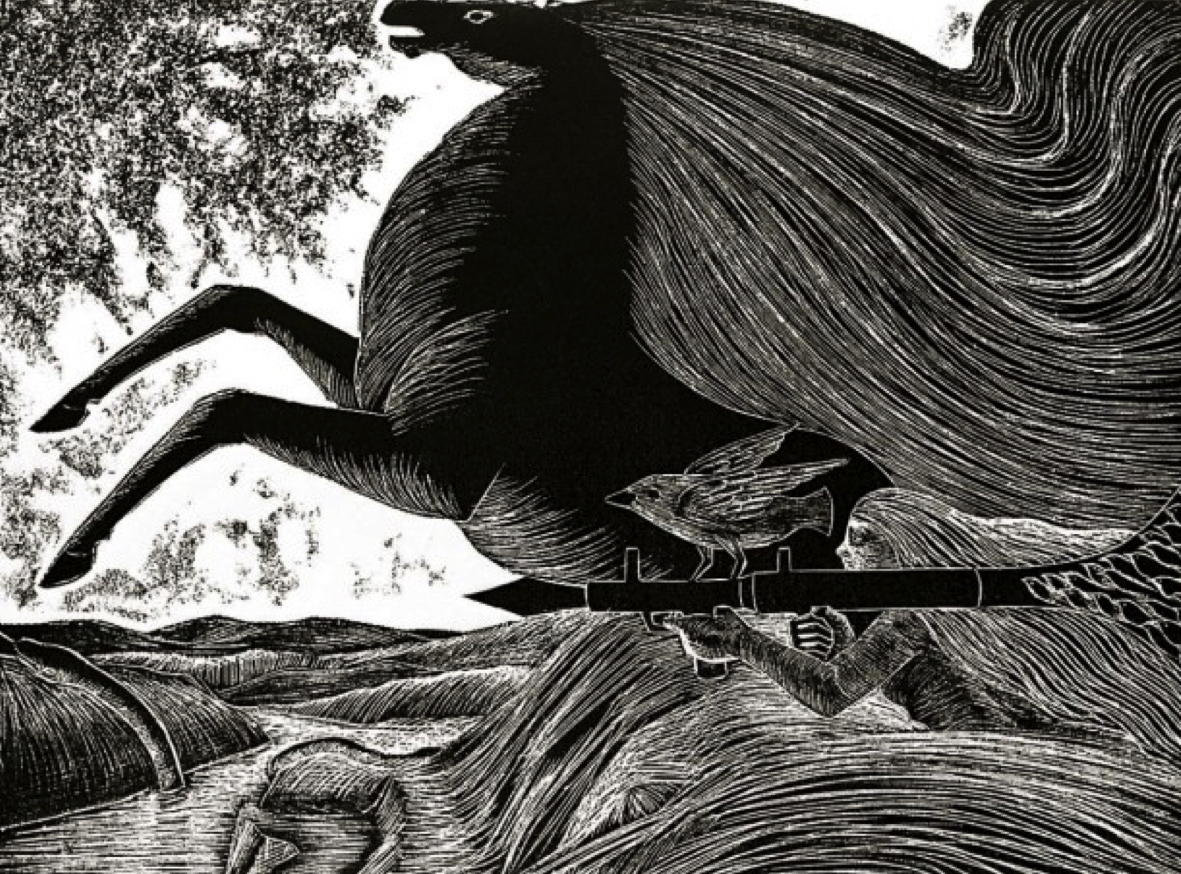
Mustafa Hallaj - The Battle of Al Karameh
The heated debate that took place in apartheid South Africa in the 80s can be compared to the events that occurred during the 70s and 80s – and that are still occurring today – in Palestine. Joseph Massad, Associate Director of Modern Arab Politics and Intellectual History at Columbia University mentioned how, in his article Permission to Paint: Palestinian Art and the Colonial Encounter, the Union of Palestinian Artists (UPA) was established in 1970 in Beirut, and initiated a major debate on aesthetics and the nature of ‘liberation art’. Accordingly, the UPA established the Al-Karameh Gallery to exhibit the works of Palestinian artists living in exile, which was soon targeted for destruction by Israeli bombers. The systematic destruction of Palestinian culture carried out by the Israeli government has inspired Palestinian artists to work in a more conceptual manner, as an intense reaction to their condition. This predicament brings to mind the words of the Irish art critic Brian O’Doherty, who once wrote that ‘as Modernism gets older, context becomes content’. The context is what is essential in assessing Palestinian art today, and what allows one to review it critically.
For these artists, the urgency of mere survival and continued resistance is most pertinent to their work. Their art lies … ‘in the act of reaching beyond the [artistic] context to capture a form of collective political expression’
Samia Halaby in her book Liberation Art of Palestine further explored the link between politics and art in the Palestinian context. Halaby, yet another Palestinian artist living in exile, identified the ‘Liberation Art’ period that came into prominence in the second half of the 20th century in both Palestine and the Palestinian diaspora. Her book, containing both words and pictures related to the Palestinian resistance, is itself an example of the struggle.
Palestinian artists in the 60s and 70s, just like liberation artists from Latin America and South Africa, were concerned with the unstable political conditions in their country, and discovered an art form affiliated with ideology and politics that could serve as a means to take positions vis-à-vis political struggles and broadly elevate political concerns. As Said noted,
It is no exaggeration to say that liberation as an intellectual mission, born in the resistance and opposition to the confinement and ravages of imperialism, has now shifted from the settled, established and domesticated dynamics of culture to its unhoused, decentered and exilic energies, energies whose incarnation today is the migrant, and whose consciousness is that of the intellectual and artist in exile.
This transformation of the liberation into an ‘intellectual mission’ is of importance, as it draws parallels between liberation and artists in exile. Specifically, it shows that a new energy has been created to confront any type of domination; the exile has now become significant and rather influential, and has the potential to use its energy. In Palestine, confrontation is not only limited to being against the Israeli government, but also includes resistance towards the Palestinian Authority (PA), the governing body of the Palestinian people in the West Bank and Gaza, in accordance with the 1993 Oslo Accords. The PA, some have argued, has narrowed the Palestinian perception of the idea of liberation as a result of corruption and the lack of a political vision. The work of Jawad Ibrahim, a Ramallah-based Palestinian artist is a case in point, particularly where his critical cartoon of the late Yasser Arafat is concerned.
Whether living in their homeland or as exiles outside it, Palestinian artists have continuously refused to surrender their aesthetic sensibilities. Given the duration and effects of the Israel-Palestine conflict, it is natural that Palestinians have looked towards it for inspiration for their art. As the British artist and writer Victor Burgin argued, ‘we must accept the responsibility of producing an art which has more than art as its content’. This notion can clearly be seen, for instance, in the works of Larissa Sansour, a young artist working primarily with video. Her projects deal with Palestinian political realities and the ways in which they have impacted conditions of everyday life. Her video installation Soup Over Bethlehem, exhibited at the 2009 Istanbul Biennial, deals with themes of exile, occupation, victimhood, and identity.
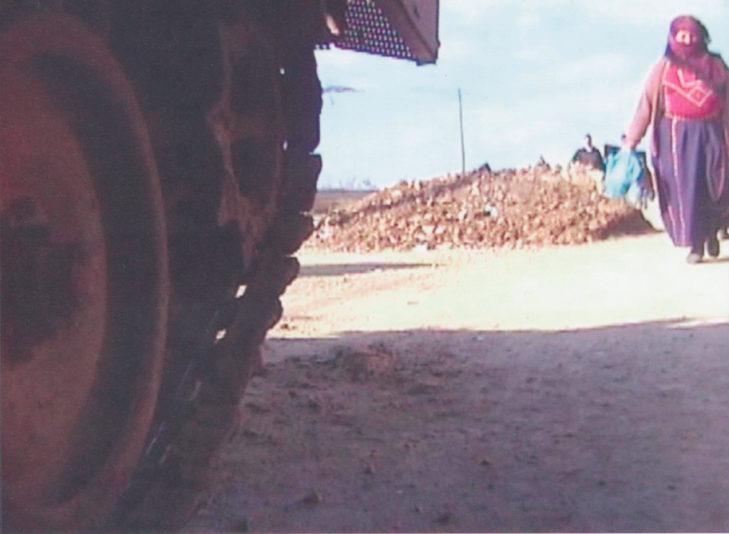
A still from Emily Jacir’s Crossing Surda
Similar to Burgin, Benjamin argued in his 1936 essay The Work of Art in the Age of Mechanical Reproduction that art loses its freedom as a result of mechanical reproduction. Art, according to such a view, becomes removed from the realm of ritual to that of politics. Benjamin felt that the task of the proletariat and the revolutionary intellectual was ‘to make the continuum of history explode’. From this perspective, it can be argued that the exiled Palestinian artist has a mission to reveal the significance of the present as well as analyse the convergence of past and future in the now, such that it can be transformed. An interesting demonstration of this notion can be witnessed in the work of Emily Jacir, an artist working between New York and Ramallah. Speaking about her 2003 work Crossing Surda – a record of going to and from work in Ramallah – Jacir noted that it came about as a result of being threatened by an Israeli soldier who held an M16 rifle to her temple. ‘[I was] filming at my feet with a video camera at a checkpoint that day. If I had not had this direct threatening experience, this piece would not exist’.
There are no danger-free zones when it comes to art and politics, especially in the case of Palestine. Palestinian artists, with renewed energy, have confronted all forms of domination. Art, for today’s generation of Palestinian artists, is the art of liberation, for it has the ability to transform, transpose, and transmit moral and aesthetic values to an oppressed people. As long as the conflict continues, there will be no refuge for the Palestinian people – artists in particular – from the necessary language of politics.
